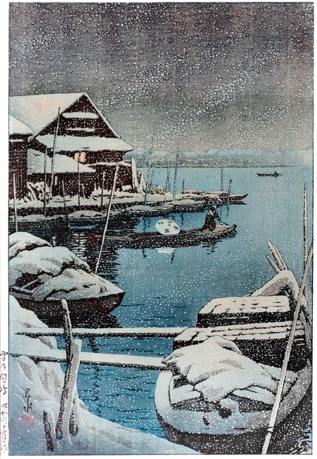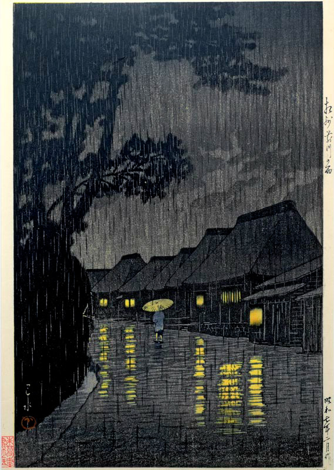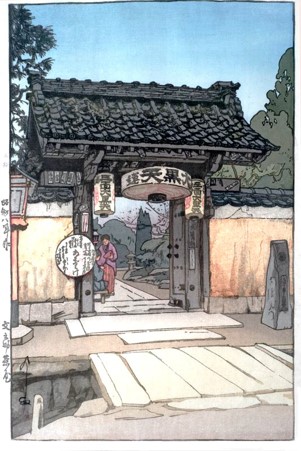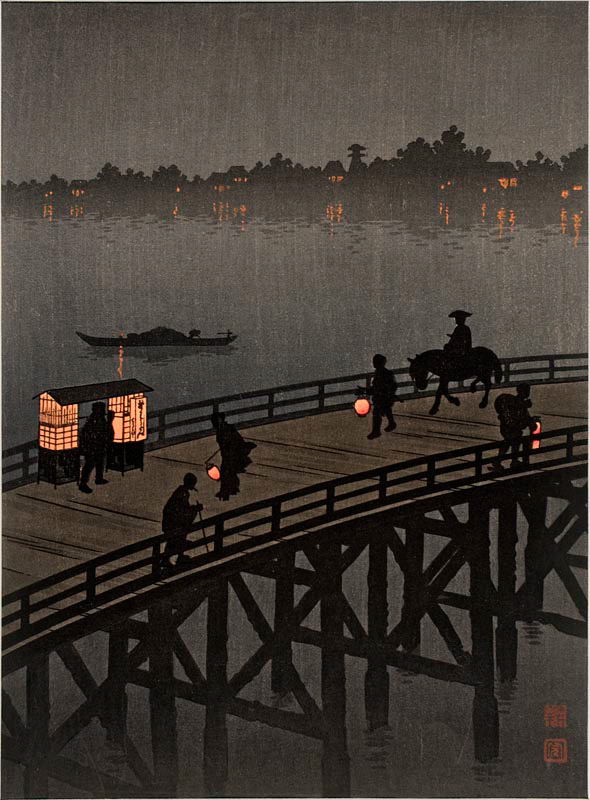By: Teddy Keenan
Overview-
After the collapse of the Tokugawa Shogunate in 1868, Japan opened up to the west. Western ideas greatly influenced the Japanese in culture, technology and art. The traditional form of Japanese printmaking (Ukiyo-e) fell from the public’s eye as more modern and western artistic styles began to get adopted. While Japan was modernizing, western audiences still held the view that Japan was a land of feudalism and foreign ideas. To appeal to the western market, artists employed a romanticized view of Japan in their art, depicting oriental scenes with a western stylistic approach. This method is called Shin hanga, which means “new print.”
Watanabe Shozaburo (1885-1962), a publisher, was a significant contributor to the Shin Hanga movement because he understood that western buyers wanted art that depicted what they already thought they knew about the orient. Shozaburo recruited many artists to train them in this manner, and one such artist was Kawase Hasui (1883-1957). Shozaburo was impressed with Hasui’s natural talent and encouraged him to focus on landscapes in particular, with an emphasis on traditional scenes. Hasui was well traveled around Japan and could create tranquil pictures. Cherry blossoms are a significant part of Japan and are seen as a traditional aspect which most Shin Hanga prints incorporate. One of Hasui’s prints in the Shain collection is Snow Storm at Kiba. In his snow prints he uses a distinct color palette and uses some traditional Japanese techniques mixed with western in his final piece. He would either portray snow as white dots, (traditional) or use lots of white lines to make a more realistic effect.
Other such artists associated with the Shin Hanga movement are Yoshida Hiroshi (1876-1950) and Shoda Koho (1871-1946). Unfortunately, little is known about the life of Shoda Koho. Yoshida Hiroshi on the other hand was also a significant contributor to Shin Hanga in the 20th century. He helped to revive the art of woodblock printmaking in the early 20th century. Hiroshi was an experimenter when it came to making art. Hiroshi held the belief that Japanese artists need to create works based on the present times in order for the art to have life, while recognizing the traditional methods of past Japanese artists. In his lifetime he traveled extensively in foreign countries and studied western methods, while innovating the process of print production. An element of western influence in his pieces is atmospheric depth especially in his landscapes.
In this exhibition, the pieces chosen all have aspects of human construction in them along with perspective, minimal color, and a focus on the surroundings of an environment instead of the people in it.

Creator: Kawase Hasui
Culture: Japanese
Date: 1931
Dimensions: 14 1/2 x 10 1/2
Medium: color woodcut
Repository: Chu Griffis online collection
Description: Kawase Hasui’s snow scene depicts a cold scene with shades of greys and dull blues all contrasted with white. Atmospheric depth makes the illusion that the mountains in the background are a far distance away. To add to the pictures depth, the boats appear to zigzag across the image and lead the viewers eye to the last boat only seen as a silhouette in the far distance. The only warm color is a faint yellow in the singular window of the house. This is a focal point as well as the dark silhouette. The various white dots that peck the image represent a snow dusting rather than a full blown snow storm. What is interesting about this piece is the way that some of the boats have been covered. Two of the boats in the foreground of the work show that they are carrying cargo with a couple sheets strewn about them in a disorganized manner. When seeing this, one may wonder if those who were out for the day in the boats came to the structure to rest for the night and didn’t anticipate the weather when leaving their cargo uncovered. Overall, Hasui’s snow print creates an intriguing storyline as well as demonstrating western styles of creating depth.

Creator: Kawase Hasui
Culture: Japanese
Date: 1932
Medium: color woodcut
Repository: Chu Griffis online collection
Description: Kawase Hasui’s wood block print depicts an intriguing scene, influenced by modernism and western stylistic elements. This particular print uses perspective to give the effect of depth throughout. There appears to be a vanishing point where the houses meet the silhouette of some trees and a path that curves around. The yellow from the houses light up the scene by creating a strong contrast with the dark, wet outside environment. The only color present in this piece is the yellow from the windows and their reflection along with a faint blue from the pedestrian’s clothing. Hasui’s print gives off a warm aura even though it depicts a dreary night sky, since the brightness coming from the village houses, which reflects in the street, draws your eye almost inside where the people are away from the storm.

Creator: Yoshida Hiroshi
Culture: Japanese
Date: 1933
Dimensions: 15 x 10
Medium: color woodcut
Repository: Chu Griffis online collection
Description: Lines and intricate detail mark this print by Yoshida Hiroshi as very western in style. In the very front of the piece, a path vanishes directly through a gate which acts as a barrier between the viewer and nature beyond. The eye is directed right through the entrance of the gate where it meets two figures resting under the roof structure. This piece has a lot of smaller details such as writing on hanging lanterns or the individual roof shingles depicted with small black lines. The wall is clearly aged with grey streaks creeping up its sides as well as cracks forming higher up. Spatially, the wall breaks the image into three pieces. The path and grey dirt is the first part while the wall, the most detailed part of the piece makes up the second part and the roof and sky make up the third part. These transitions allow the viewer to focus on the middle of the piece where the most is happening visually as well as where the scene is taking us.

Creator: Shoda Koho
Medium: Color woodcut
Date: Early 20th Century
Culture: Japanese
Repository: Shain library, Collection of Japanese woodcuts
Description: Shoda koho’s color woodcut print stands out as a particularly unique piece in the Shain Library art collection. To capture the eye, bright orange from a distant village reflects across a body of water bringing the viewers attention to pedestrians traveling over a bridge. Lanterns of the same hue, light their way as they are depicted as black silhouettes against a gray haze. The softness of the night sky contrasts pleasingly with the warmth of the orange. Underneath the bridge, the structural support makes a geometric pattern which greatly deviates from the organic shapes of the village and villagers. This particular piece is roughly positioned in thirds from top to bottom. The distant village in the background marks the first distinction while the bridge in the foreground marks the second distinction, making the negative space around the background and foreground the variance of spaces. Whether the individuals on the bridge are just going home after a long day or making their way to work, this piece shows how life goes on even when the night sky replaces the daylight.

Creator: Yoshida Hiroshi
Medium: Color woodcut
Date: 1925
Dimensions: 27.5 x 40 cm (10 13/16 x 15 3/4 in.)
Culture: Japanese
Repository: Museum of fine arts Boston
Description: The presentation of Yoshida Hiroshi’s Sphinx is a quite distinct print when compared with some of his other works or other Japanese artists of his time. Firstly, the subject matter of the Egyptian sphinx rather than an idyllic Japanese scene represents how well traveled Hiroshi was, being able to experience a foreign landscape and still produce a distinctly Shin Hanga print from abroad. Secondly, by seeing Japanese art depicting foreign scenes outside of Japan and Asia all together, it can be concurred that Japanese prints have a universal quality that is not limited to just Japan. The print incorporates a background, middle ground and foreground. The background is much lighter in hue which depicts the atmospheric depth in the piece. the blue of the sky greatly contrasts with the yellow sandstone and desert environment. Individuals are also seen in this piece riding camels. The individuals are printed with light, dull colors, making them blend in with the environment. This allows the viewers sole focus to be on the face of the Sphinx where the sun illuminates it up.
Bibliography:
Kawase Hasui, Japanese, 1883-1957. Snow, Mukojima. Images, n.d. https://jstor.org/stable/community.9895080.
Kawase Hasui, Japanese, 1883-1957. Rain at Maekawa, Sagami. Images, n.d. https://jstor.org/stable/community.9900742.
Shoda Koho, Japanese, 1875-1946? Senju Bridge, Night. Images, n.d. https://jstor.org/stable/community.9888140.
Yoshida Hiroshi, Japanese, 1876-1950. Little Temple Gate. Images, n.d. https://jstor.org/stable/community.9892474.
Blair, Dorothy. “Hiroshi Yoshida, 1876-1950.” Artibus Asiae 14, no. 1/2 (1951): 163–68. http://www.jstor.org/stable/3248691.
Zinkow, Leszek. (2018). The art of Two easts: the Great Sphinx on the Woodblock Prints of Hiroshi Yoshida, Fascination with Otherness 9 perspektywy kultury / perspectives on culture numer 19 (4/2017). Perspektywy Kultury. 19.
LaLonde, Sydney. “Bridging East and West: The Search for … – Digital Commons.” Digital Commons @ Connecticut College. Friends of the Library Occasional Publications, January 23, 2008. https://digitalcommons.conncoll.edu/cgi/viewcontent.cgi?article=1002&context=folpub.